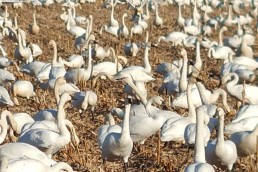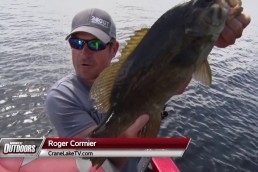Acres of Swans on Western Lake Erie Area Marshes, Cornfields
SHARE THIS POST
For waterfowl hunters, bird watchers and casual observers alike, the annual passage of large flocks of North America’s largest waterfowl often make people stop on the road and stare at their impressive size, striking white plumage and cacophony of sounds coming from thousands of these noisy birds.
They typically can be seen each fall south of the Ottawa National Wildlife Refuge or Magee Marsh Wildlife Area foraging in cornfields, winter rye or wheat.
Three swan species are seen in North America. Two of the three are native, including Tundra swans and Trumpeter swans. Decorative European Mute swans are now established in many locations.
Tundra swans are the smallest of the three species. They typically weigh less than 16 pounds, with a wingspan of about 5.5 feet. Their bills are the shortest of the three species, being less than 1.5 inches from the nostrils to the tip, compared to over 2 inches for the other two species.
When looking at them head-on, the origin of the bill is “U-shaped” between the eyes, which appear separated from its thin, black stripes that emanate from the rear of the bill to them. Sometimes a faint, yellow blotch may be detected at the base of the bill on the eastern population.
On European and western specimens, the yellow “splotch” is very prominent. The European Tundra swan subspecies is known as a Bewick’s swan.
A chorus of swans
The eastern population was estimated by the U.S. Fish and Wildlife Service in 2015 to be approximately 117,100, with the western count fewer at 56,300.
They migrate southward through the area in late fall and back northward in the early spring and are the species making up the bulk of the large flocks of swans observed in Ohio.
Tundra swans just migrate through and do not nest in Ohio, so they are not managed by the Ohio Division of Wildlife.
However, the DOW has specific goals in place in their Swan Management Plan for the other two species as described below.
Trumpeter swans can be separated from Tundra swans by looking at their bill head-on and seeing the “V-Shaped” base with a wider black stripe that virtually hides their eyes.
They reach weights of 24 to 28 pounds with a wingspan of up to 10 feet. Yet, despite this size, a few are shot by mistake almost every year during the waterfowl season by hunters mistaking them for snow geese.
Ohio waterfowlers need to realize that snow geese seldom come through the area. They are also only a fraction of the size of any of the swans, at only three to seven pounds, have black wing tips, a much shorter neck and an orange bill.
Are you enjoying this post?
You can be among the first to get the latest info on where to go, what to use and how to use it!
A bird whose outlook was bleak
Trumpeter swans were extirpated from Ohio in the early 1700s and faced extinction throughout North America due to unregulated hunting of them for their meat, skin that was used to make powder puffs, wing feathers for fancy quill pens and their eggs.
Luckily, a population of only 69 birds survived near Yellowstone National Park. When a previously unknown population was discovered in Alaska in the 1950s, fresh genetic material was available to mix with captive birds in the possession of collectors and zoos for rehabilitating their population in the Continental United States, including Ohio.
They have been re-introduced into suitable wetlands in Ohio since 1996, with their population steadily expanding from the initial release sites.
In 2017, Northwest Ohio’s District 2 had 20 successful nesting pairs, mostly in the Western Lake Erie marshes. District 3, in northeast Ohio came in second, with seven successful nesting pairs, two in District 1 and one in District 4. Better survival of the cygnets through Mute swan culls have allowed the population to increase significantly.
The Division of Wildlife’s Trumpeter swan management plan includes having breeding pairs in 15 Ohio counties and have 40 pairs by 2020 for three consecutive years, before considering the de-listing the species.
In 2017, there were breeding pairs in 17 counties, but only successful in 11 counties. So, the species status remains listed as “Threatened.”
Because Trumpeter swans were reintroduced from captive stock, they were not taught migration routes from their parents and consequently make little or short migrations from their breeding territory.
Mutes blasted, Trumpeters beloved
The European Mute swan is considered a feral, domestic waterfowl and is not subject to the protection offered to other waterfowl by the Migratory Bird Treaty Act.
As an aggressive, undesirable, nuisance invasive species, several states control their numbers by addling their eggs or shooting them to promote the survival of Trumpeter swans, including Ohio Division of Wildlife personnel.
Mute swans aggressively defend their territory from native waterfowl and other species, including humans. One field mark is their unique knob at the base of their light-colored or pink bill.
They grow up to 30 pounds and consume up to eight pounds of aquatic vegetation daily, robbing native waterfowl of this food source.
Ohio’s swan management plan for Mute swans stipulates having zero present on public lands and no population growth on other lands within Ohio by 2020, due to their negative impacts.
Tundra swans make an impressive sight for as long they remain our guests on the way to their winter range along the Atlantic coast from New Jersey to North Carolina.
MWO
SHARE THIS POST
Did you enjoy this post?
You can be among the first to get the latest info on where to go, what to use and how to use it!
John Hageman
John Hageman was manager of Stone Laboratory, Ohio Sea Grant's Biology Station at Put-in-Bay, for 25 years and formerly a licensed Lake Erie ice-fishing guide. He is active with the Outdoor Writers of Ohio and several sportsmen's conservation organizations. He may be contacted at hageman.2@osu.edu.



